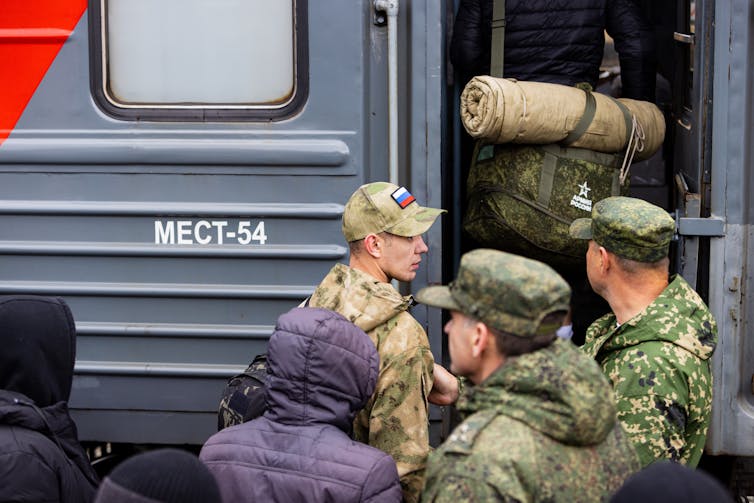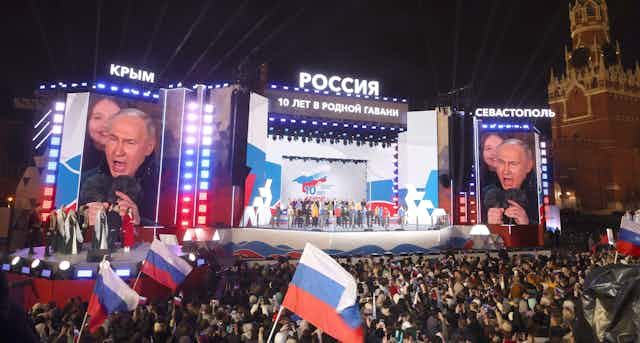Basking in his wholly expected re-election victory, Russian president, Vladimir Putin, addressed a large crowd in Moscow’s Red Square on March 18 to mark the 10th anniversary of his country’s annexation of Crimea.
The familiar themes of rectifying a historical injustice, the unbreakable unity of the Russian people and the importance of Crimea to Russian identity were trotted out once again. The crowd duly applauded.
Yet compared to ten years ago, when the whole country appeared to be in the grip of collective ecstasy, the celebrations seemed muted. Much has changed in the intervening ten years, not least that Putin’s miscalculations have put the status of Crimea in doubt again.
On the peninsular itself, life has changed profoundly. The “land of milk and honey” promised to the population of Crimea at the time of annexation has not materialised. International sanctions, high prices and increasing uncertainty have left the mainstay of the economy, tourism, in the doldrums. And the democratic freedoms that existed under Ukraine have disappeared, not only for the Ukrainian and Tatar populations, but for the Russians too.
The security of Crimea is also under threat as at no time since 2014. Ukrainian rockets and drones have destroyed about 20% of the Russian Navy’s Black Sea Fleet, including the flagship Moskva. And the Kerch bridge – the symbol of Putin’s triumph – has been subject to repeated attacks.
The Russian navy has been driven ignominiously from its bases in Crimea to the safer haven of Novorossisk in Russia itself. Ships carrying Ukrainian grain can now exit the Black Sea due to defeats inflicted on the Russian fleet.
In one area, however, the Russians have enjoyed success. The Russification of the peninsula is continuing apace.

‘Russian World’
Russification of Crimea is not an ad hoc policy imposed after the occupation. It is rooted in the ideology of Russkii MIr (“Russian World”). This concept, which is espoused by Putin, is itself part of a long historical tradition going back to the annexation of the Crimea by Catherine the Great in 1783.
The Russian World ideology insists that Russia is a supra-national civilisation that extends far beyond the present borders of the Russian Federation to include Ukraine, Belarus, Kazakhstan and other parts of the former Soviet Union. At the same time, the ideology is intolerant of any other expression of identity within its sphere and justifies the elimination of that identity, as is taking place in Crimea.
The Imperial Russian state (1721–1917), the Soviet State (1917–1991) and now the Russian Federation under Putin have at different times all sought to Russify the population of the Crimean peninsular. The Imperial government encouraged the migration of Tatars from the peninsular and Stalin completed the process in 1944 by deporting the entire Tatar population – some 200,000 people.
A partial return took place under Krushchev (premier of of the Soviet Union between 1958 and 1964), which greatly accelerated when the Crimea became part of a democratic Ukraine. Putin has now reversed that policy, seeking the destruction of both the Tatar and Ukrainian identities.
Eradicating non-Russian identity
Putin swore to safeguard the different national traditions that existed in Crimea when he launched the annexation. These promises were broken immediately and have continued to be broken ever since.
Ukrainian and Tatar languages have been suppressed, political activists arrested and any expression of cultural identity other than Russian is forbidden. The national body of the Crimean Tatars, the Mejlis, has been suppressed and all other representative institutions are a sham, as those in Russia itself.
Religious persecution against the Ukrainians and the Tatars, which is actively assisted by the Russian Orthodox Church, is also an essential part of the Russification policies.
What is striking about the Russification of Crimea is its comprehensive nature and the ruthlessness with which it is being carried out. A major instrument of Russification has been the imposition of Russian citizenship on the population of the peninsular. This has been achieved through a combination of incentives and crude threats.
Access to vital services such as health, education, banking, pensions and jobs are dependent on acceptance of Russian citizenship. No passport means that these services are not available. The refusal of Russian citizenship has lead to confiscations of property, expulsion from the peninsular and even threats to take away the children of those retaining Ukrainian citizenship.
Acceptance of citizenship makes men eligible for military service. And Putin’s government has ruthlessly mobilised men from the Crimea and the Donbas. A new citizenship law in April 2023 extended these practices to the territories occupied since 2022.

These changes have been accompanied by demographic changes that have taken place since the annexation. According to Russian figures, at least 200,000 Russians have migrated to Crimea since 2014. Ukrainian figures suggest that 50,000 Ukrainians and Tatars have left over the same period.
This is a form of ethnic cleansing designed to make the Crimea irrevocably Russian and protect it against any fair referendum that might return the peninsular to Ukraine.
The ten years since the annexation of Crimea has been a dismal exercise in the suppression of a multi-ethnic and multi-cultural society by a ruthless regime that tolerates no identities apart from the one that it prescribes. Russification in Crimea has also provided a model that has been imposed on Ukrainian territory taken since 2022 and is a grim warning to any future lands that fall under Russian occupation.

